
John Wood Campbell Jr. was an American science fiction writer and editor. He was editor of Astounding Science Fiction from late 1937 until his death and was part of the Golden Age of Science Fiction. Campbell wrote super-science space opera under his own name and stories under his primary pseudonym, Don A. Stuart. Campbell also used the pen names Karl Van Kampen and Arthur McCann. His novella Who Goes There? was adapted as the films The Thing from Another World (1951), The Thing (1982), and The Thing (2011).
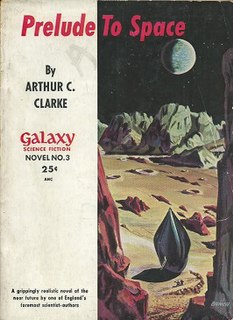
Prelude to Space is a science fiction novel written by British author Arthur C. Clarke in 1947. It appeared for the first time in 1951 as a paperback from World Editions Inc, as number three in its series of Galaxy novels. Sidgwick & Jackson published it in the UK in 1953, followed the next year by a United States hardcover edition from Gnome Press and a paperback from Ballantine Books.

Unknown was an American pulp fantasy fiction magazine, published from 1939 to 1943 by Street & Smith, and edited by John W. Campbell. Unknown was a companion to Street & Smith's science fiction pulp, Astounding Science Fiction, which was also edited by Campbell at the time; many authors and illustrators contributed to both magazines. The leading fantasy magazine in the 1930s was Weird Tales, which focused on shock and horror. Campbell wanted to publish a fantasy magazine with more finesse and humor than Weird Tales, and put his plans into action when Eric Frank Russell sent him the manuscript of his novel Sinister Barrier, about aliens who own the human race. Unknown's first issue appeared in March 1939; in addition to Sinister Barrier, it included H. L. Gold's "Trouble With Water", a humorous fantasy about a New Yorker who meets a water gnome. Gold's story was the first of many in Unknown to combine commonplace reality with the fantastic.

Startling Stories was an American pulp science fiction magazine, published from 1939 to 1955 by publisher Ned Pines' Standard Magazines. It was initially edited by Mort Weisinger, who was also the editor of Thrilling Wonder Stories, Standard's other science fiction title. Startling ran a lead novel in every issue; the first was The Black Flame by Stanley G. Weinbaum. When Standard Magazines acquired Thrilling Wonder in 1936, it also gained the rights to stories published in that magazine's predecessor, Wonder Stories, and selections from this early material were reprinted in Startling as "Hall of Fame" stories. Under Weisinger the magazine focused on younger readers and, when Weisinger was replaced by Oscar J. Friend in 1941, the magazine became even more juvenile in focus, with clichéd cover art and letters answered by a "Sergeant Saturn". Friend was replaced by Sam Merwin Jr. in 1945, and Merwin was able to improve the quality of the fiction substantially, publishing Arthur C. Clarke's Against the Fall of Night, and several other well-received stories.
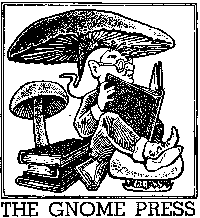
Gnome Press was an American small-press publishing company primarily known for publishing many science fiction classics. Gnome was one of the most eminent of the fan publishers of SF, producing 86 titles in its lifespan — many considered classic works of SF and Fantasy today. Gnome was important in the transitional period between Genre SF as a magazine phenomenon and its arrival in mass-market book publishing, but proved too underfunded to make the leap from fan-based publishing to the professional level. The company existed for just over a decade, ultimately failing due to inability to compete with major publishers who also started to publish science fiction. In its heyday, Gnome published many of the major SF authors, and in some cases, as with Robert E. Howard's Conan series and Isaac Asimov's Foundation series, was responsible for the manner in which their stories were collected into book form.
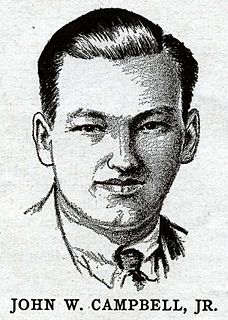
This is a bibliography of works by American writer John W. Campbell Jr.
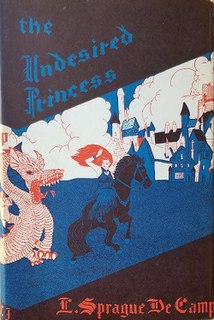
The Undesired Princess is a 51,000 word fantasy novella by American writer L. Sprague de Camp. It was first published in the fantasy magazine Unknown Worlds for February 1942. It was published in book form by Fantasy Publishing Company, Inc. in 1951. The book version also includes the 10,000 word fantasy short story "Mr. Arson", first published in Unknown for December 1941. The book was bound together with Stanley G. Weinbaum's The Dark Other in the omnibus collection Fantasy Twin by the same publisher in 1953. The title story was also published in paperback by Baen Books in 1990 together with David Drake's story The Enchanted Bunny, under the combined title The Undesired Princess & the Enchanted Bunny.
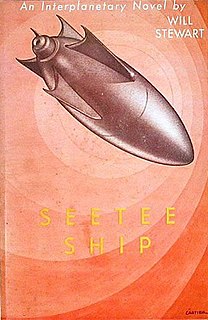
Seetee Ship is a science fiction novel by American writer Jack Williamson, writing under the pseudonym Will Stewart. The second in the Seetee series, it is a fix-up adapting two stories previously published in Astounding Science Fiction magazine, "Minus Sign" and "Opposites—React!".
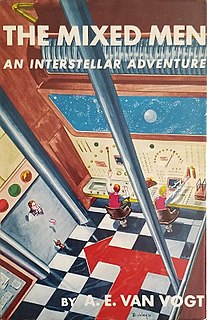
The Mixed Men is a fix-up novel of science fiction short stories by Canadian-American writer A. E. van Vogt that focus on the mixed offspring of Dellian Supermen and human beings. The novel's title is taken from van Vogt's 1945 Astounding SF short story "Mixed Men", which was nominated for a Retro-Hugo Award in 1996. The stories published in the novel were originally released between the years of 1943 to 1945 in Astounding SF, with the novel being first published in a 5,000 copy printing in 1952 by Gnome Press and a 1955 Berkley Books edition under the title Mission to the Stars.

Pattern for Conquest is a science fiction novel by American writer George O. Smith. It was published in 1949 by Gnome Press Reprinted circa 1952 in paper wrappers for distribution to US military personnel. Although a later printing, the first edition statement is retained on the copyright page. [Currey] isfdb Currey

Minions of the Moon is a science fiction novel by American writer William Gray Beyer, originally serialized in the magazine Argosy in 1939. It was published in book form in 1950 by Gnome Press in an edition of 5,000.
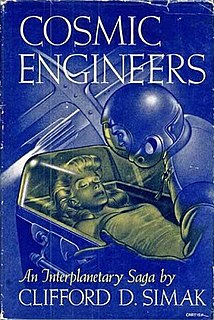
Cosmic Engineers is a science fiction novel by American author Clifford D. Simak. It was published in 1950 by Gnome Press in an edition of 6,000 copies, of which 1,000 were bound in paperback for an armed forces edition. The novel was originally serialized in the magazine Astounding in 1939.
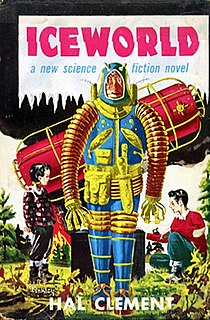
Iceworld is a science fiction novel by American writer Hal Clement. It was published in 1953 by Gnome Press in an edition of 4,000 copies. The novel was originally serialized in the magazine Astounding in 1951.

The Moon Is Hell! is a collection of science fiction stories by American writer John W. Campbell Jr. It was published in 1950 by Fantasy Press in an edition of 4,206 copies. The title story deals with a team of scientists stranded on the Moon when their spacecraft crashes, and how they use their combined skills and knowledge to survive until rescue, including building shelter from meteor showers, and creating their own oxygen from Lunar rock. The second story, "The Elder Gods", Campbell rewrote, on a short deadline, from a story by Arthur J. Burks purchased for Unknown but later deemed unsatisfactory. It originally appeared in that magazine under the pseudonym Don A. Stuart. The title of the eponymous story is generally reported without the exclamation point, although the punctuation is used for the title of most editions of the collection itself.

Seeds of Life is a science fiction novel by American writer John Taine. It was first published in 1951 by Fantasy Press in an edition of 2,991 copies. The novel originally appeared in the magazine Amazing Stories Quarterly in October 1931.
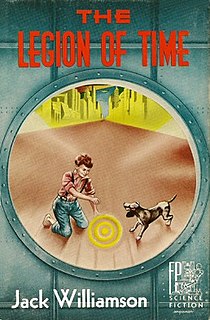
The Legion of Time is a collection of two science fiction novels by the American writer Jack Williamson. It was first published by Fantasy Press in 1952 in an edition of 4,604 copies. The novels were originally serialized in the magazines Astounding Science Fiction and Marvel Stories.
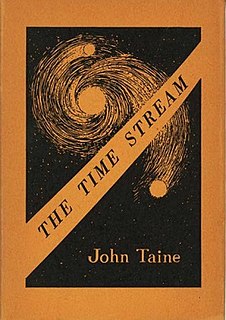
The Time Stream is a science fiction novel by American writer John Taine. The novel was originally serialized in four parts in the magazine Wonder Stories beginning in December 1931. It was first published in book form in 1946 by The Buffalo Book Company in an edition of 2,000 copies of which only 500 were ever bound. It is the first novel to see time as a flowing stream.

The Blind Spot is a science fiction novel by American writers Austin Hall and Homer Eon Flint. The novel was originally serialized in six parts in the magazine Argosy beginning in May 1921. It was first published in book form in 1951 by Prime Press in an edition of 1,500 copies, though fewer than 800 were actually bound, and the remainder are assumed lost. The sequel, The Spot of Life, was written by Hall alone.

The Cosmic Geoids and One Other is a collection of two science fiction novellas by author John Taine. It was first published in 1949 by Fantasy Publishing Company, Inc. in an edition of 1,200 copies. The title novella is a loose sequel to Taine's novel, The Time Stream, and was later serialized in the magazine Spaceway, in three parts beginning in December 1954. The other novella, "Black Goldfish", was first serialized in the magazine Fantasy Book, in two parts beginning in 1948.

Science-fiction and fantasy magazines began to be published in the United States in the 1920s. Stories with science-fiction themes had been appearing for decades in pulp magazines such as Argosy, but there were no magazines that specialized in a single genre until 1915, when Street & Smith, one of the major pulp publishers, brought out Detective Story Magazine. The first magazine to focus solely on fantasy and horror was Weird Tales, which was launched in 1923, and established itself as the leading weird fiction magazine over the next two decades; writers such as H.P. Lovecraft, Clark Ashton Smith and Robert E. Howard became regular contributors. In 1926 Weird Tales was joined by Amazing Stories, published by Hugo Gernsback; Amazing printed only science fiction, and no fantasy. Gernsback included a letter column in Amazing Stories, and this led to the creation of organized science-fiction fandom, as fans contacted each other using the addresses published with the letters. Gernsback wanted the fiction he printed to be scientifically accurate, and educational, as well as entertaining, but found it difficult to obtain stories that met his goals; he printed "The Moon Pool" by Abraham Merritt in 1927, despite it being completely unscientific. Gernsback lost control of Amazing Stories in 1929, but quickly started several new magazines. Wonder Stories, one of Gernsback's titles, was edited by David Lasser, who worked to improve the quality of the fiction he received. Another early competitor was Astounding Stories of Super-Science, which appeared in 1930, edited by Harry Bates, but Bates printed only the most basic adventure stories with minimal scientific content, and little of the material from his era is now remembered.




















